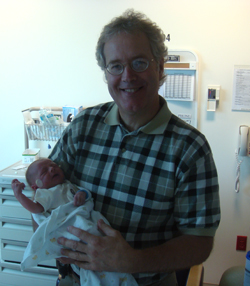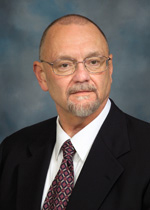 |
Kim Duncan, M.D., holds Johnny Raynor — the grandson of Tom O’Connor, senior associate director of public affairs. Dr. Duncan repaired a congenital heart defect in the child days after his birth. |
Johnny entered the world on June 20 at Children’s Hospital — the firstborn child for my daughter, Kelly, and her husband, J.P. Raynor. He weighed exactly 7 pounds and was 19 inches long. It was a conventional vaginal delivery.
Although he looked perfectly normal, Johnny had a monster lurking inside. He had a major congenital heart defect known as transposition of the great arteries (TGA).
We first learned that Johnny had TGA when Kelly had an ultrasound in the 20th week of her pregnancy.
Trust me when I tell you it seemed like the longest pregnancy in the history of civilization. We couldn’t wait for Johnny to arrive, but we also knew he faced major challenges once he left his mother’s womb.
With TGA, the aorta and pulmonary artery are reversed. The aorta receives oxygen-poor blood from the right ventricle, but it’s carried back to the body without receiving more oxygen. Likewise, the pulmonary artery receives oxygen-rich blood from the left ventricle but carries it back to the lungs.
All patients with TGA require open-heart surgery early in life to survive. For Johnny, his surgery came on July 2 at Children’s Hospital — just 12 days after he was born.
The thought of having open-heart surgery is unnerving. But, when it involves an innocent 12-day-old baby, it makes you swallow extra hard.
Fortunately, we had a true expert at the controls. Kim Duncan, M.D., professor and chief of cardiothoracic surgery at UNMC, performed the surgery. Over the course of his career, he’s done nearly 200 surgeries on TGA patients.
The surgery he performed is called the arterial switch operation. The aorta and pulmonary artery are switched back to their normal positions. The aorta is connected to the left ventricle, and the pulmonary artery is connected to the right ventricle. The coronary arteries, which carry oxygen-rich blood that nourishes the heart muscle, also need to be reattached to the new aorta.
Sounds simple, huh? The whole process took about six hours with Johnny on a heart-lung bypass machine about a third of the time.
When he came out of surgery, Johnny’s chest was covered with a large dressing, and he must have had a dozen lines going into his body. He looked like he’d been through a train wreck.
|
|
It all sounds pretty routine. But Johnny’s survival is truly a testament to the advances of modern medicine and medical research.
If you turn back the clock to the 1950s, there was no surgical procedure for TGA. Johnny would have developed serious lung disease within a few months and died.
It wasn’t until the 1960s when a surgical procedure for TGA was developed by William Mustard, M.D., from the University of Toronto. The Mustard procedure was the norm until the mid-1980s when the arterial switch operation became the standard.
Dr. Duncan performed the Mustard procedure early in his career. In 1985, he witnessed his first arterial switch operation, as he went to England to observe another surgeon perform the procedure. The results were far from desirable — the child died on the table.
“We’ve come a long way,” Dr. Duncan said. “Anesthesiology has improved so much, and we have a much better understanding of small babies. Two of the keys were the development of two-dimensional echocardiography and the discovery of using prostaglandins to keep open the blood vessel that runs between the aorta and the pulmonary artery.
“The echocardiography transformed congenital heart surgery. It made it safer and much more efficient. It gave us a cross sectional picture of the of the anatomy and allowed us to better view the heart and the blood vessels. Prostaglandins are a natural form of hormones found in virtually all tissues and organs.”
It’s estimated that one in every 150 births will have some sort of major heart defect requiring surgical intervention, Dr. Duncan said. Each year, between 10 and 15 children will have TGA in the Omaha area. Incredibly, two other babies besides Johnny had TGA while he was at Children’s Hospital.
Although congenital heart defects are the most common kind of birth defect, their cause is a mystery. In more than 80 percent of cases, there is no known genetic or environmental basis that can be identified.
As my wife, Karen, said, “These things just don’t happen to us. They happen to others.” Not so. Congenital heart defects can happen to anyone. One of my colleagues in public affairs also had a daughter who had a congenital heart defect requiring open-heart surgery.
 |
Tom Rosenquist, Ph.D. |
Working with associated scientists in Houston, Berkeley, Calif., Holland and China, the UNMC researchers are trying to determine how genes expressed early in development may interact with environmental exposures to the mother in ways that predict abnormal heart development.
“We compare genetic analyses of babies, environmental and nutritional data from their mothers and test these results in experimental animal models of heart development,” Dr. Rosenquist said. “In this way, we will discover the causes of abnormal development and ways to predict its occurrence. Only with this kind of predictive ability will there be any possibility of prevention. And while surgeons like Dr. Duncan can do miraculous things to save effected babies, the obvious best solution ultimately is prevention.”
Thankfully, the outlook for Johnny is bright. “We have TGA children who are now 30 years out from surgery,” Dr. Duncan said. “Probably 85 to 90 percent of these people are living normal lives. Some go on to medical school or get their Ph.D. Some turn out to be derelicts. They’re just like the rest of society. This is not going to limit Johnny.”
 As we waited outside the Newborn Intensive Care Unit to see Johnny after his surgery, I’ll never forget the words from another mother whose own child had been treated for a serious heart problem.
As we waited outside the Newborn Intensive Care Unit to see Johnny after his surgery, I’ll never forget the words from another mother whose own child had been treated for a serious heart problem.
“Don’t worry,” she said. “Dr. Duncan is the bomb!”
I couldn’t agree more. Just look at Johnny Raynor.